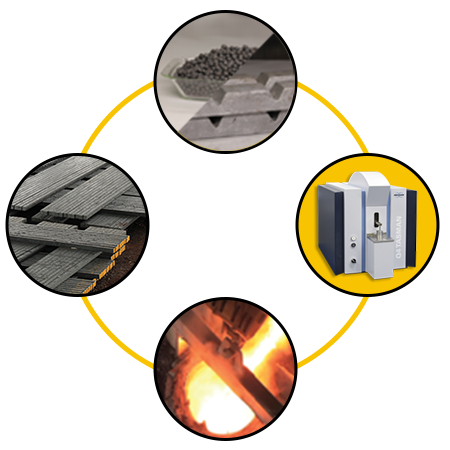What are Steel Billets?
Steel Billets are freshly made steels, that are converted into the shape of a rectangle [or] a square metal bar. Before the steel products are sold in the market, they should first be processed into more functional pieces, because the raw steel cannot be used for construction purposes. Billets, or ingots (Billets are sometimes referred as Ingots), cannot be used until they have been casted into more functional shapes and sizes. After loading it into the furnace, they still require a series of shaping and molding procedures such as hot and cold working, milling and cutting before they are sent to the dealer shops. Steel billets have distinct characteristics with high flexibility when they are in the varying temperatures during molding and shaping.
Advantages
Billets are good and magnificent raw materials for Bar (TMT & CRS) manufacturing. Billets are made by Ladle pouring Method to avoid defects like Blow Holes, Piping and Cracks. This is a major reason for the Unshakable Strength of Amman-TRY Bars.
PROCESS

Furnace: The capacity of our induction furnace is 25Mt. The furnace is lined with silica ramming mass.
Raw Material: We are using Raw Materials like Sponge Iron, Iron Ore, Imported shredded Raw Material, HMS, M.S., Boring and Graded Quality Raw Materials.
Method: The Raw Material is charged into the furnace by Electro Magnet and the furnace is switched on. The charging of different grades of Raw Material is done at intervals. When the furnace is half full sample will be taken for chemical analysis. When the furnace level is 3/4 again sample will be taken and analyse to ensure correct chemical composition in liquid metal. When the furnace is almost full chemistry will be checked again and the temperature is measured. When temperature reaches 1600 degree centigrade, calculated amount of aluminum followed by Ferro alloys like Ferro manganese, Ferro silicon, silico manganese, etc., will be added and the temperature will be raised.
Tapping: When the temperature reaches around 1650 degree centigrade the liquid metal will be poured into a refractory lined preheated red hot ladle. To ensure uniform mixing of liquid metal and bring down the liquid metal temperature to 1610-1615 degree centigrade Nitrogen purging will be done.
Casting: The final ladle temperature of L.M will be taken in the Continous Casting Machine (CCM) and the ladle is placed at the ladle seat. When the ladle is opened by hydraulically operated slide-gate system the liquid metal fall to the tundish placed under the ladle. When the tundish is ¾ full the two tundish nozzles will be opened and the metal stream falls in to the water cooled mould tubes (100mm). Aluminum wire feeding is done in the mould tube to ensure physical quality of billets.
The L.M. gets cooled in the mould tube and a shell thickness of 7 to 10mm is attained in the mould tube. The partially solidified billet will come out of the mould tube and will be further cooled by spraying of water at required pressure in the cooling chamber. When the billets come out of the cooling chamber it will be solid. The billet then passes through the straightner where it will get straightened.
Billet Cutting: The straightened billets are then cut into required length by gas. The cut billets will be allowed to cool at the skid bank for some time. Billet sample will be taken and analyzed by spectrometer.
Billet sample will be taken and etched to ensure the billets are free from physical defect like cracks, inclusions, piping, and rhomboidity, etc.,
Billet Identification: The billets are then transferred to the stock yard and proper identification numbers will be given to the billets. Now the billets are ready for dispatch.
| Size | Grade |
|---|---|
| 100 x 100 mm | IS 2830, IS: 14650 |